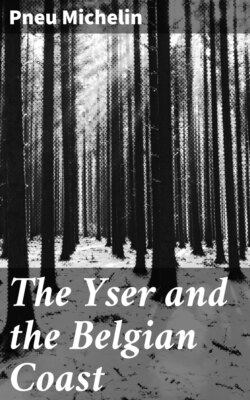Читать книгу The Yser and the Belgian Coast - Pneu Michelin - Страница 6
На сайте Литреса книга снята с продажи.
The Battlefield.
ОглавлениеTable of Contents
The last strip of unconquered Belgian territory, on which the German thrust was destined to be broken, forms part of Maritime Flanders (See map, p. 6).
This vast plain was formerly a sea-gulf, and as late as the 11th century, was often raided by the "drakkers" of the Scandinavian pirates. In the Middle-Ages, the gulf gradually filled up with sand. This vast polder is almost entirely below sea-level at high tide, and is each day invaded by the waves.
Water is everywhere: in the air, on the ground, under the ground.
It is the land of dampness, the kingdom of water. It rains three days out of four. The north-west winds, breaking off the tops of the stunted trees, making them bend as if with age, carry heavy clouds of cold rain formed in the open sea. As soon as the rain ceases to fall, thick white mists rise from the ground, giving a ghost-like appearance to men and things alike. (Le Goffic's, "Dixmude").
Line of Defence near Noordschote.
The Battlefield.
Water, which oozes up out of the soil, giving a blister-like appearance to the soft clay covering, is found at a depth of less than three feet.
This water was carefully drained off, under the control of the Belgian State, by associations of farmers and land-owners ("gardes wateringues"). Countless ditches and canals ("watergands") skirting the willow hedges and intersecting the entire plain, carried away this surplus water.
All the canals and ditches communicate with numerous water-courses, e.g. the Yperlée, Kemmelbeck, Berteartaart, Vliet and many other nameless ones, which run between embankments into the Yser.
The road from Furnes to Ypres, near Westvleteren, in December 1915.
(See page 127.)
The Yser, a small coastal river, having its source in French Flanders empties itself into the sea between two jetties. Its shallow bed, dredged along the greater part of its course, describes a wide semi-circle. At its mouth, at Nieuport, the Yser and the canals which likewise end there, are closed by a series of locks, which shut out the sea at high tide and prevent it from invading the plain through the streams and canals.
The few roads and the Nieuport-Dixmude railway run along embankments seven to ten feet high.
Formerly, flocks of sheep and herds of cattle, tended by grey-coated shepherds, grazed in this plain. Immense fields of beet and turnips alternated with the meadows. Hedges, willows, clusters of bending poplars, and the roofs of the low farmsteads built on little hillocks, broke the monotony of the landscape. Here, where peace and prosperity reigned, the inundations and war have left a vast expanse of reeds, in which the roads, ruined farmhouses and a few broken trees stand out dismally.
The plain is bounded on the west by a line of wind-formed sand dunes planted with oyats. These dunes extend along the straight unbroken coast. To the east of Dixmude rises a series of heights, which, marking the beginning of the solid ground, are continued further east by the long unbroken crest of Clerken.
South of this crest stretches the Forest of Houthulst, now entirely devastated by shellfire.
The spongy nature of the soil makes it impossible to excavate to any depth, nor was there any high ground to mask the defence-works and batteries of artillery.
Two great embankments: that of the Yser, arc-shaped, and that of the Nieuport-Dixmude railway, connecting up to the two ends of the former, were the framework of the defence lines. However, the dominating element: water, provided the defenders with a supreme and irresistible arm.
